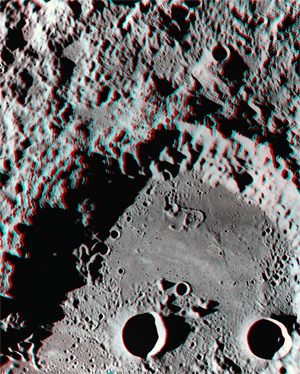
| Project Home | About the Scans | Browse Gallery | Image Map | Support Data | Resources | Ephemeris |
Featured Image - 5/20/2008
Van de Graaf Crater
This picture shows the northeast corner of Van de Graaf crater, located on the far side of the Moon south of Aitken crater on the outer edge of the South-Pole Aitken basin. This area has several unique characteristics First, a relatively strong magnetic field was detected near this crater by the Apollo 15 subsatellite magnetometer. This discovery was unusual for the lunar surface because the Moon does not currently have a global magnetic field like the Earth does! Second, Van de Graff and the surrounding area also have slightly higher concentrations of thorium, which suggests the presence of a geochemically important thorium-rich lunar material called KREEP. Finally, if you look closely at the crater walls, you can see an unusual grooved texture. But why does the Van de Graaf region display all of these unique features?
Figure 1: Van de Graaf crater on the lunar far side.
(Apollo Image AS15-M-0075 [NASA/JSC/Arizona State University])
It turns out that the Van de Graaf region is antipodal (which means "on the exact opposite side of the Moon") to the giant Imbrium impact basin on the lunar near side. Some lunar scientists have therefore suggested that the unusual grooved terrain is a result of either the convergence of basin ejecta at this antipodal point or compression by the massive seismic waves generated by the basin-forming impact. The strong magnetic field could also be a product of the interaction between the superheated basin ejecta and the lunar surface materials at the impact point. If the terrain features and the strong magnetic field are really products of ejecta from the Imbrium basin-forming impact event, then the elevated thorium concentrations would make sense, because the Imbrium region has some of the highest thorium concentrations on the lunar surface and the ejecta from the basin-forming impact would have been thorium-rich, too. However, the elevated thorium concentrations could also be from thorium-rich materials near Van de Graaf crater.
Figure 2: Anaglyph image with exaggerated topography of Van de Graaf crater on the lunar far side created using Apollo Metric Images AS15-M-0075 and AS15-M-0076. Click on the image to see it in higher resolution. Note: You will need 3D glasses to see this image correctly.
[NASA/JSC/Arizona State University]
The best way to answer these questions is exploration of the region by humans and robotic helpers. The measurements made by the the Lunar Reconnaissance Orbiter and other lunar precursor lunar missions will give the next generation of lunar field geologists the necessary data to plan future expeditions to the Van de Graaf region and address these questions.
For more information, read:
L. L. Hood et al. (1979) "The Moon: Sources of the Crustal Magnetic Anomalies" Science, 204, 4388, pp.53-57.
P. H. Schultz and D. E. Gault (1974) "Seismic Effects From Major Basin Formations on the Moon and Mercury" The Moon, 12, pp. 159-177.
Tweet
![]()

|
|
Space Exploration Resources |
|
 LPI LPI
|

